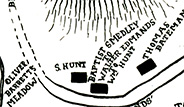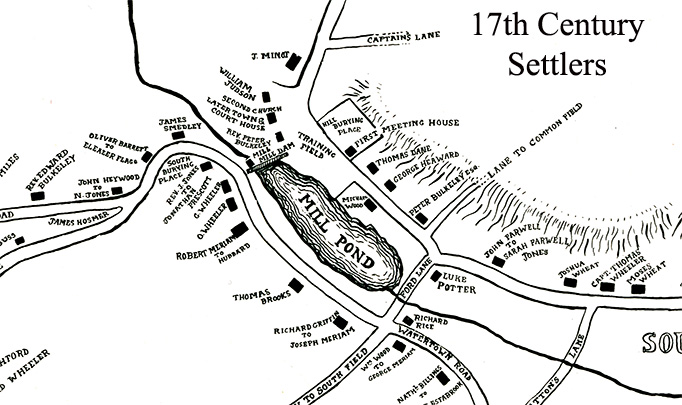
The Mythical Twelve First Families of Concord
Concord Journal, December 16, 1954
Winthrop’s Journal, written in 1635 at the time Concord was incorporated, says that the town was granted to Mr. Peter Bulkeley and about twelve families. Shattuck’s History of Concord (1835) and Walcott’s Concord in the Colonial Period (1884) repeat this statement. Subconsciously, we picture a little procession of twelve men with their women and children making their way through the trackless woods with the clergyman at their head. The question then arises: Who were these twelve?
The Concord Town Records are of no help, because the book of land grants begins in 1653 and here we have more than fifty owners. Nine years before, a large group had gone to Fairfield, Connecticut, so it is impossible to reduce this number to twelve.
The County records of births and burials gives us the following list of surnames in Concord between 1639 and 1644: Atkinson, Bennett, Blood, Brooks, Brown, Bulkeley, Buss, Chandler, Costin, Dane, Doggett, Draper, Edmunds, Edwards, Evarts, Fowle, Farwell, Flint, Fuller, Fox, Gamline, Halsted, Hartwell, Harvey, Heaward, Hosmer, Jones, Lettin, Hunt, Martin, Meriam, Miles, Odell, Potter, Prentice, Rice, Rogers, Squiers, Symons, Thwing, Tompkins, Turney, Underwood, Wheate, Wheeler, Willard, Wood. But the records are, by their nature, incomplete.

17th Century Map of Concord's Settlers
Other early settlers we know from the land grants were Adams, Aline, Baker, Ball, Barrett, Bateman, Bellows, Billings, Burgess, Buttrick, Dakin, Davis, Fletcher, Gove, Hall, Heald, Heywood, Howines, Jeffrey, Judson, Mason, Rigby, Smith, Scotchford, Stow, Smedley, Taylor, West, Wigley (Wylie), Willcocks, Woodis, and Wooley. Thus there were at least seventy early families who had births, burials or land ownership during the first six years.
Charles E. Banks published in 1930 a list of Planters of the Commonwealth compiled from contemporary resources. He found the names of about one-tenth of the twenty thousand people who poured into the Bay Colony during the first fifteen years. He adds the names of Beardsley and Thwaites to those we already have listed. He gives the most detailed account we have of the English origins of the emigrants and finds that in the whole colony, twenty percent came from the East Anglia counties of Essex, Sussex, and Middlesex.
In the case of some Concord families, genealogists have discovered the places of origin but no complete compilation has ever been made. What we do know is that the places were scattered. Bulkeley and Wheeler were from Bedfordshire, Willard and Hosmer from Kent, Flint from Derby, Hunt from York, and Heald from Northumberland, for example. Our guides are instructed to tell visitors that Concord people particularly loved independence because they came from Kent. Both sides of this statement are still not proven and, in this one case, it seems to me, perhaps our guides are handing out fiction.
How can this list be reduced to twelve? A petition signed by Lettin, Draper, and some of the Wheelers states that they came here late (in 1638 or 1639) and had to buy their land, but this still leaves more than seventy families.
Something becomes clear at this point. The twelve families referred to by Gov. Winthrop who joined with Mr. Bulkeley must have been those who joined to petition the General Court for the land grant. We know from the records that Mr. Spencer was one of these. He lived out his life in Cambridge although he was active in getting the act in incorporation and in the purchase from the Indians. His mill site and Brook Valley made a handsome reward for his efforts. But he was not a first settler. Probably some others of the twelve incorporators did not move here. Simon Willard was another of the incorporators, who had interests in many other places.
Cambridge was in a ferment. The salt marshes along the Charles and the clay marshes between Fresh Pond and the Mystic cut down on the good planting land available there. The original bounds of Watertown included half of Brattle Street in present-day Cambridge. The land-hungry Cambridge settlers had explored the vacant land toward the Merrimac and beyond Ipswich and finally decided to go to Hartford, outside the jurisdiction of the Bay Colony. On that long journey about sixty men, women, and children went with their pastor, Thomas Hooker. It is impossible to make a similar picture of Mr. Bulkeley and twelve families setting out for Concord.
The act of incorporation itself provided another method of settlement. When the planter had located his lot he could go to the magistrate of the nearest town (Medford, Cambridge, or Watertown) and ask for oxen in order to carry goods to Concord, and the magistrates had the power to impress the oxen of some established settler there. This went on for several years. The Watertown records report the objections of the farmers to the loss of their oxen for days at a time during the busy season.
So the picture of the settlement becomes a picture of restless Cambridge residents, eager new arrivals, and established merchants planning together for the settlement, agreeing on the first division of land into house-lots of 3 to 10 acres, then exploring the best road and moving out, a few families at a time, until the group was consolidated by the signing of the church covenant and the ordination of two ministers.
Mr. Bulkeley paid the expenses to settle a carpenter and a miller here and probably to settle others, and the carpenter doubtless went to work to get a house ready for Mr. Bulkeley. Perhaps a store house, to be used later for a meeting house, was first completed. Pious Plymouth had no church, only a store house at first, and Watertown built a store house a year before a church was started.
The first shelters were built by digging into the gravel ridge, with timbers around the entrance and sods thrown onto the timbers as Johnson describes it in his Wonder Working Providence (1654). Of the first seventy families, several undoubtedly moved to other Massachusetts or Connecticut towns before the larger migration with Rev. John Jones in 1644, so that as time went on, there were fewer families here rather than more. A few new names came in—Prescott, Lee, Minot, Stratton, Goble, and Pellet—but these did not equal the withdrawals.
The second division of land made in the third decade of the settlement served to stabilize the population. Death took its toll of some childless families like that of John Scotchford, our first town clerk. Families with only girl children account for some lost surnames. Those families with the foresight and the capital to buy up the lots abandoned by the transients had second division land granted, on account of those lots, as well as of their own, and soon we had the big outlying farms which remained in many cases in one family for two or three hundred years.
Title to the land came from the General Court by virtue of the Colony Charter to the Town and from the Town to the first settlers. Transfers were made just as they are today. Included in the original land grant however, was a right to a second division of land and a right to pasture cattle on the common land. American land could not be entailed but the eldest son usually got a double portion.
For convenience in making the divisions, the settlers divided the town into three sections or quarters. The word quarter here means district, not a fourth part. There were three, because the original lots were laid out in three parts, those south of the mill pond, those along the ridge to the east and those along the ridge to the north of the mill pond. Each of these quarters had its own grazing land in common and by 1653 the outlying land was well enough known so that the men in each quarter could agree on the second division of land in that quarter.
People sometimes claim to own land by grant from the king, but I have never seen a deed to Concord land from the king, although the deed usually refers to the year of the king’s reign and this can confuse people unaccustomed to the legal phraseology and the handwriting of the period.